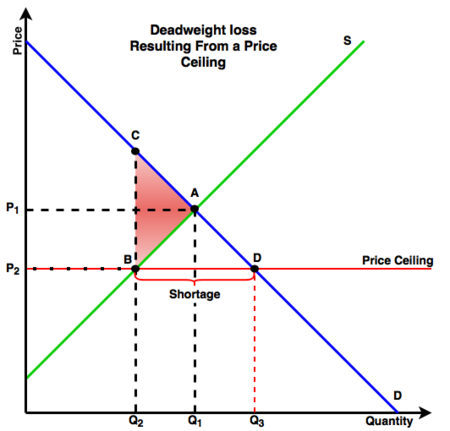Deadweight loss

A deadweight loss is the result of inefficiencies in a market resulting from a poor allocation of goods and services.[2] Inefficiencies can be produced by a number of factors such as price controls, wage laws (minimum/maximum wage), unequal market share (monopoly and any other factor that keeps a market out of equilibrium. Despite the name, a deadweight loss isn't always bad, these losses are often put in place because of political values like worker equity. These cases are called necessary inefficiencies.
Figure 1 shows a market where a price ceiling has been put in, a price ceiling it the maximum price that a good can be sold for. The price ceiling knocks the market out of equilibrium.
- At Point A The market is in equilibrium, supply (S) meets (D) and the price (P1) and quantity (Q1) reflect this.
- When the price ceiling in inserted, P1 is no longer an option so the market moves to Point B.
- At Point B the price (P2) is the maximum that the ceiling will allow and the quantity (Q2) does not meet the demand, this causes a shortage of supply.
- At the price (P2) the quantity should be (Q3) but due to the low price the producer would go out of business if it produced to Point D.
- Because of this restriction, the market is inefficient and results in the deadweight loss (Red Triangle ABC).
Necessary Inefficiency
An inefficient market is not necessarily a bad thing. Some restrictions on the market can be better for society despite the inefficiencies they create.
For example, a minimum wage can be implemented to ensure that every worker in an economy will earn a basic income. A basic level of income can ensure that people can meet the cost of living. While this creates a deadweight loss in the market it reduces the need for people to rely on the government for benefits such as low income grants. A minimum wage should be reasonable however, if it is too high or a large increase is implemented at once it can create a heavy burden for employers. Small businesses are often the most affected by rises in the minimum wage and if the rise is too much or too quick it can shock small businesses can cause them to fail. In effect, if the rise is too large or fast the inefficiency is too great and can cause a market failure.
A feed in tariff (FIT) is a policy that would create some deadweight loss in the market for energy (usually on the price of electricity production). Because the FIT keeps the price constant or above a certain level for a period of time, there is a deadweight loss because the market cannot act freely and allocate itself as demand and supply interact. The deadweight loss resulting from the implementation of an FIT is regarded as a necessary inefficiency because it is done to reduce [emissions]] resulting form conventional methods of electrical generation.

